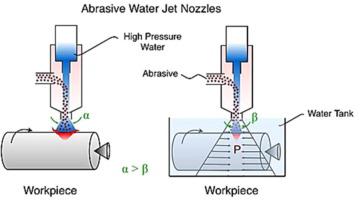当前位置:
X-MOL 学术
›
Eng. Sci. Technol. Int. J.
›
论文详情
Our official English website, www.x-mol.net, welcomes your feedback! (Note: you will need to create a separate account there.)
Performance evaluation of the submerged abrasive water jet turning process for improving machinability of castamide
Engineering Science and Technology, an International Journal ( IF 5.7 ) Pub Date : 2020-08-01 , DOI: 10.1016/j.jestch.2020.06.009 Salem A. Basher Ibrahim , Seyma Korkmaz , M. Huseyin Cetin , Fuat Kartal
Engineering Science and Technology, an International Journal ( IF 5.7 ) Pub Date : 2020-08-01 , DOI: 10.1016/j.jestch.2020.06.009 Salem A. Basher Ibrahim , Seyma Korkmaz , M. Huseyin Cetin , Fuat Kartal

|
Abstract In this study, the submerged abrasive water jet turning (AWJT) system was used for improving machinability of castamide material and process parameters have been investigated comprehensively. Optimum parameters were determined as to minimize the surface roughness and maximize the material removal rate in the submerged turning process of castamide. 3-level traverse speed (TS), abrasive flow rate (AFR) and spindle speed (SS) were taken as the input parameters, and the experimental design was made as a full factorial design. The effect ratios of the input parameters were analyzed statistically by ANOVA and graphical methods, and their interactions were examined by 3D surface images. Optimum test condition was determined by TOPSIS and VIKOR methods. Experimental results were compared with conventional abrasive water jet process. In addition, regression equations were obtained for the explanation of the experimental results mathematically to show the relationships between the variables. According to the experimental results, submerged AWJT increased the surface roughness of castamide material by 15% compared to conventional AWJT and decreased the metal removal rate by 5.22%. ANOVA results showed that the traverse speed is the most effective parameter on the machinability of castamide. Traverse speed was found to be 83.11% effective on surface roughness and 85.56% on material removal rate. According to TOPSIS and VIKOR optimization results, 40 mm/min TS, 310 g /min AFR and 300 rpm SS values were determined as the optimum test conditions.
中文翻译:

水下磨料水射流车削工艺提高蓖麻酰胺可加工性的性能评价
摘要 在这项研究中,水下磨料水射流车削(AWJT)系统被用于提高铸酰胺材料的可加工性,并对工艺参数进行了全面的研究。确定了最佳参数,以最大限度地减少表面粗糙度,并最大限度地提高铸酰胺水下车削过程中的材料去除率。以三级横动速度(TS)、磨料流量(AFR)和主轴转速(SS)为输入参数,实验设计为全因子设计。通过方差分析和图形方法对输入参数的影响比进行统计分析,并通过 3D 表面图像检查它们的相互作用。最佳试验条件由TOPSIS法和VIKOR法确定。实验结果与传统磨料水射流工艺进行了比较。此外,得到回归方程用于数学解释实验结果,以显示变量之间的关系。实验结果表明,与常规AWJT相比,浸没式AWJT使castamide材料的表面粗糙度提高了15%,金属去除率降低了5.22%。方差分析结果表明,横动速度是影响蓖麻酰胺可加工性的最有效参数。发现横移速度对表面粗糙度的有效率为 83.11%,对材料去除率的有效率为 85.56%。根据 TOPSIS 和 VIKOR 优化结果,确定 40 mm/min TS、310 g/min AFR 和 300 rpm SS 值作为最佳测试条件。实验结果表明,与常规AWJT相比,浸没式AWJT使castamide材料的表面粗糙度提高了15%,金属去除率降低了5.22%。方差分析结果表明,横动速度是影响蓖麻酰胺可加工性的最有效参数。发现横移速度对表面粗糙度的有效率为 83.11%,对材料去除率的有效率为 85.56%。根据 TOPSIS 和 VIKOR 优化结果,确定 40 mm/min TS、310 g/min AFR 和 300 rpm SS 值作为最佳测试条件。根据实验结果,与常规AWJT相比,浸没式AWJT使castamide材料的表面粗糙度提高了15%,金属去除率降低了5.22%。方差分析结果表明,横动速度是影响蓖麻酰胺可加工性的最有效参数。发现横移速度对表面粗糙度的有效率为 83.11%,对材料去除率的有效率为 85.56%。根据 TOPSIS 和 VIKOR 优化结果,确定 40 mm/min TS、310 g/min AFR 和 300 rpm SS 值作为最佳测试条件。发现横移速度对表面粗糙度的有效率为 83.11%,对材料去除率的有效率为 85.56%。根据 TOPSIS 和 VIKOR 优化结果,确定 40 mm/min TS、310 g/min AFR 和 300 rpm SS 值作为最佳测试条件。发现横移速度对表面粗糙度的有效率为 83.11%,对材料去除率的有效率为 85.56%。根据 TOPSIS 和 VIKOR 优化结果,确定 40 mm/min TS、310 g/min AFR 和 300 rpm SS 值作为最佳测试条件。
更新日期:2020-08-01
中文翻译:

水下磨料水射流车削工艺提高蓖麻酰胺可加工性的性能评价
摘要 在这项研究中,水下磨料水射流车削(AWJT)系统被用于提高铸酰胺材料的可加工性,并对工艺参数进行了全面的研究。确定了最佳参数,以最大限度地减少表面粗糙度,并最大限度地提高铸酰胺水下车削过程中的材料去除率。以三级横动速度(TS)、磨料流量(AFR)和主轴转速(SS)为输入参数,实验设计为全因子设计。通过方差分析和图形方法对输入参数的影响比进行统计分析,并通过 3D 表面图像检查它们的相互作用。最佳试验条件由TOPSIS法和VIKOR法确定。实验结果与传统磨料水射流工艺进行了比较。此外,得到回归方程用于数学解释实验结果,以显示变量之间的关系。实验结果表明,与常规AWJT相比,浸没式AWJT使castamide材料的表面粗糙度提高了15%,金属去除率降低了5.22%。方差分析结果表明,横动速度是影响蓖麻酰胺可加工性的最有效参数。发现横移速度对表面粗糙度的有效率为 83.11%,对材料去除率的有效率为 85.56%。根据 TOPSIS 和 VIKOR 优化结果,确定 40 mm/min TS、310 g/min AFR 和 300 rpm SS 值作为最佳测试条件。实验结果表明,与常规AWJT相比,浸没式AWJT使castamide材料的表面粗糙度提高了15%,金属去除率降低了5.22%。方差分析结果表明,横动速度是影响蓖麻酰胺可加工性的最有效参数。发现横移速度对表面粗糙度的有效率为 83.11%,对材料去除率的有效率为 85.56%。根据 TOPSIS 和 VIKOR 优化结果,确定 40 mm/min TS、310 g/min AFR 和 300 rpm SS 值作为最佳测试条件。根据实验结果,与常规AWJT相比,浸没式AWJT使castamide材料的表面粗糙度提高了15%,金属去除率降低了5.22%。方差分析结果表明,横动速度是影响蓖麻酰胺可加工性的最有效参数。发现横移速度对表面粗糙度的有效率为 83.11%,对材料去除率的有效率为 85.56%。根据 TOPSIS 和 VIKOR 优化结果,确定 40 mm/min TS、310 g/min AFR 和 300 rpm SS 值作为最佳测试条件。发现横移速度对表面粗糙度的有效率为 83.11%,对材料去除率的有效率为 85.56%。根据 TOPSIS 和 VIKOR 优化结果,确定 40 mm/min TS、310 g/min AFR 和 300 rpm SS 值作为最佳测试条件。发现横移速度对表面粗糙度的有效率为 83.11%,对材料去除率的有效率为 85.56%。根据 TOPSIS 和 VIKOR 优化结果,确定 40 mm/min TS、310 g/min AFR 和 300 rpm SS 值作为最佳测试条件。


























 京公网安备 11010802027423号
京公网安备 11010802027423号